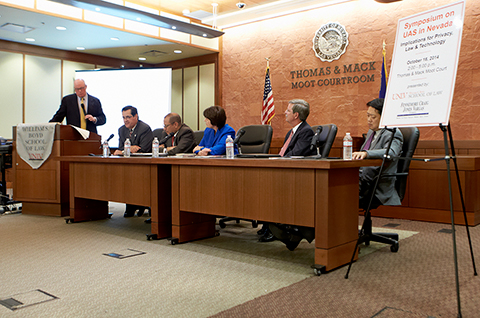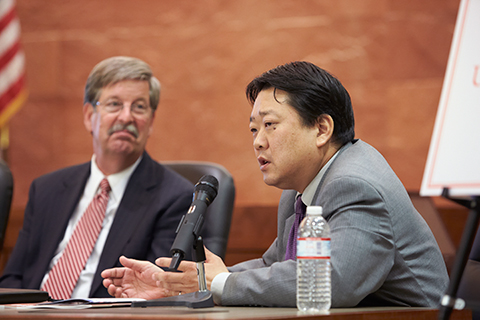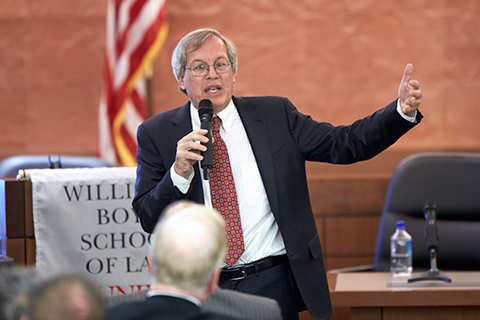Boyd School of Law Symposium Highlights Potential Legal Implications of Drones

|
| (From left) Steve Sebelius, Las Vegas Review-Journal; Tom Wilczek, Industry Specialist - Aerospace & Defense, Nevada Governor’s Office of Economic Development; John Valery White, Executive Vice President and Provost, UNLV and Chairman, Nevada Institute of Autonomous Systems; Dr. Lynn Fenstermaker, Associate Research Professor, Desert Research Institute; Richard Jost, Director, Fennemore Craig Jones Vargas; Paul Oh, Lincy Professor of Unmanned Aerial Systems, UNLV Howard R. Hughes College of Engineering |
Earlier this year, the Federal Aviation Administration designated Nevada one of six test sites for the integration of unmanned aerial systems (UAS) commercial applications into the U.S. airspace. With this comes considerable optimism for economic growth. Some early estimates indicate the potential for 10,000 new jobs with an economic impact of $2.5 billion by the middle of the next decade.
But with all that positive news comes the reality that UAS, also referred to as drones, are becoming a legal hot-button issue. As UAS technology evolves, new laws, regulations and changes to existing laws will be needed to assure citizens their privacy is protected and the new devices are used for the public good.
A Symposium on UAS in Nevada, held at UNLV’s Thomas & Mack Moot Court on Oct. 16, brought plenty of “What if” scenarios surrounding the legal implications for drones. But above all, government, academic and legal experts seemed to agree that finding what is right and fair when it comes to regulating UAS could involve plenty of trial and error as well as cooperation between the public and private sectors. Below are a few highlighted points from the symposium.
Public opinion
The symposium, a partnership between the Boyd School of Law and local law firm Fennemore Craig Jones Vargas, first looked at public attitudes toward a variety of UAS uses.
Criminal Justice professor Joel Lieberman and a team of researchers recently conducted three studies that sampled U.S. and Nevada public opinions about different UAS uses.
For the U.S. studies, Lieberman noted a more-than-90-percent approval rate for climate and geological uses. Traffic monitoring and military operations saw approvals topping 70 percent as well. More than 1,000 people were surveyed for each study.

|
| (From left) Richard Jost, Director, Fennemore Craig Jones Vargas; Paul Oh, Lincy Professor of Unmanned Aerial Systems, UNLV Howard R. Hughes College of Engineering |
But support dipped below 50 percent for activities like crowd and criminal activity monitoring; and, in general, respondents felt more comfortable with drone surveillance activities being done by the federal government and police agencies, not private citizens. That finding was ironic, given the concerns about oversized government coming out of some media and political circles today.
“It’s an interesting contradiction,” Lieberman added.
Overall, Nevadans were more accepting of UAS uses than others around the country, showing slightly higher approval percentages in all usage categories. Lieberman speculates military influence and a longer history with UAS in the state could be reasons for greater acceptance among Nevadans.
Panel discussion, privacy
A panel of experts at the event included UNLV Executive Vice President and Provost John Valery White, Lincy Professor of Unmanned Aerial Systems Paul Oh, Fennemore Craig Jones Vargas Director Richard Jost, Desert Research Institute Associate Research Professor Lynn Fenstermaker, and Nevada Governor’s Office of Economic Development Industry Specialist – Aerospace & Defense Tom Wilczek (Boyd School of Law Class of '01).

|
| Erwin Chemerinsky, Dean and Distinguished Professor of Law and Raymond Pryke Professor of First Amendment Law, University of California, Irvine School of Law |
The group discussed some of the potential legal hurdles for UAS in a variety of contexts, including police use; protecting gathered data from hackers; and, to a greater extent, reasonable expectations citizens have of privacy. Should citizens expect certain levels of privacy even while in public? And where should lines be drawn when it comes to fair ways of obtaining data through the use of drones? These were some of the questions the group said will be tackled with future legislation and the federal and state judiciary systems.
“There’s a tension between great utility and the potential for misuse,” Jost summarized.
White and Wilczek also cautioned that laws enacted in anticipation of UAS uses could potentially thwart technological and economic progress.
“You tend to not legislate ahead of technology, but, instead, respond to technology,” White said. “To try to anticipate usage and develop legal rules to regulate that usage is sort of a bad idea. … We can’t guess all the uses.”
But Erwin Chemerinsky, dean of the University of California, Irvine School of Law – a leading scholar in constitutional law – delivered the keynote speech and gave plenty of hints that proactive legislation may not be a bad thing.
In his remarks, Chemerinsky said Fourth Amendment principles are “insufficient to deal with UAS,” and there is a need to develop protections for information privacy.
Chemerinsky cited numerous Supreme Court decisions where Fourth Amendment search and seizure protections were upheld, then others where they were not. It’s these precedents that have him concerned about drone legal problems related to how information is collected and used.
Chemerinksy closed by highlighting the California Privacy Act, passed roughly 15 years ago. Under the law, it is not permissible to use technology to gain images or sound otherwise requiring a physical trespass. Tennessee is currently considering a similar law.
“I think this law could be a model for states across the country,” he added.